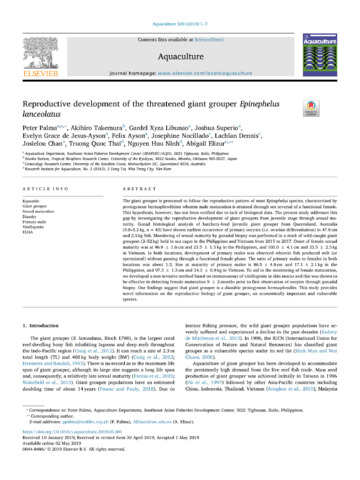Reproductive development of the threatened giant grouper Epinephelus lanceolatus

View/
Date
2019-05-02Author
Page views
898Metadata
Show full item recordCited times in Scopus
Share
Abstract
The giant grouper is presumed to follow the reproductive pattern of most Epinephelus species, characterized by protogynous hermaphroditism wherein male maturation is attained through sex reversal of a functional female. This hypothesis, however, has not been verified due to lack of biological data. The present study addresses this gap by investigating the reproductive development of giant groupers from juvenile stage through sexual maturity. Gonad histological analysis of hatchery-bred juvenile giant grouper from Queensland, Australia (0.8–5.2 kg, n = 43) have shown earliest occurrence of primary oocytes (i.e. ovarian differentiation) in 47.8 cm and 2.5 kg fish. Monitoring of sexual maturity by gonadal biopsy was performed in a stock of wild-caught giant groupers (2–52 kg) held in sea cages in the Philippines and Vietnam from 2015 to 2017. Onset of female sexual maturity was at 96.9 ± 1.6 cm and 23.5 ± 1.5 kg in the Philippines, and 103.0 ± 4.1 cm and 33.5 ± 2.5 kg in Vietnam. In both locations, development of primary males was observed wherein fish produced milt (or spermiated) without passing through a functional female phase. The ratio of primary males to females in both locations was about 1:2. Size at maturity of primary males is 86.5 ± 4.8 cm and 17.1 ± 2.1 kg in the Philippines, and 97.3 ± 1.3 cm and 34.3 ± 0.9 kg in Vietnam. To aid in the monitoring of female maturation, we developed a non-invasive method based on immunoassay of vitellogenin in skin mucus and this was shown to be effective in detecting female maturation 9 ± 2 months prior to first observation of oocytes through gonadal biopsy. Our findings suggest that giant grouper is a diandric protogynous hermaphrodite. This study provides novel information on the reproductive biology of giant grouper, an economically important and vulnerable species.
Suggested Citation
Palma, P., Takemura, A., Libunao, G. X., Superio, J., de Jesus-Ayson, E. G., Ayson, F., Nocillado, J., Dennis, L., Chan, J., Thai, T. Q., Ninh, N. H., & Elizur, A. (2019). Reproductive development of the threatened giant grouper Epinephelus lanceolatus. Aquaculture , 509, 1-7. https://doi.org/10.1016/j.aquaculture.2019.05.001
Collections
- AQD Journal Articles [1249]
